On the morning of the fifth of August 1898, a large rock entered the atmosphere over Maine, USA. Traveling at around 50 times faster than Concorde, it plunged from frictionless space into ever thickening layers of air. Atmospheric ram pressure began sharply braking the descent at around 50 miles above the ground, with the energy being dissipated by heating the air ahead white hot, and ablating the surface of the stone.
At about 30 miles overhead, the atmospheric ram pressure would have been so great as to disintegrate the meteor, with fragments finally being slowed to the regular terminal velocity of a falling body.
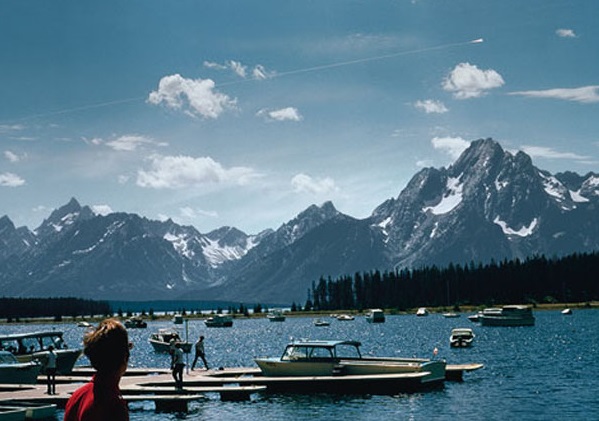
Such an event produces a bolide, or fireball in the sky, visible for many tens of miles around, day or night. The image above is of the 1972 Great Daylight Fireball which just skimmed the atmosphere, and didn't rain down meteorites as at Andover, Maine in 1898 -
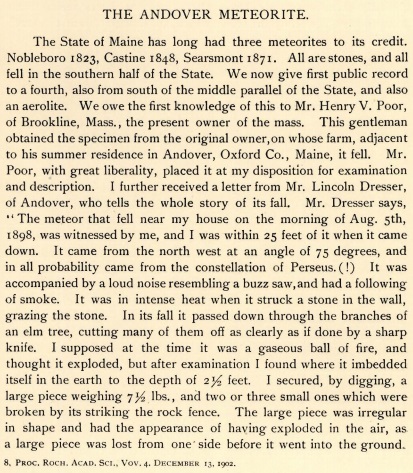

 from Description of Four Meteorites, Henry A. Ward, 1902
from Description of Four Meteorites, Henry A. Ward, 1902
At this point I'd like to point out that there is no evidence concerning cloud cover on the fifth of August '98. For the sake of holding this shaky post together with the most tenuous of links, I'm hoping the reader will assume that the day was cloudless. With this assumption, the daytime fireball of the Andover meteorite would easily have been visible from Paris, a small town 28 miles from Andover. And at a gemstone mine nearby....
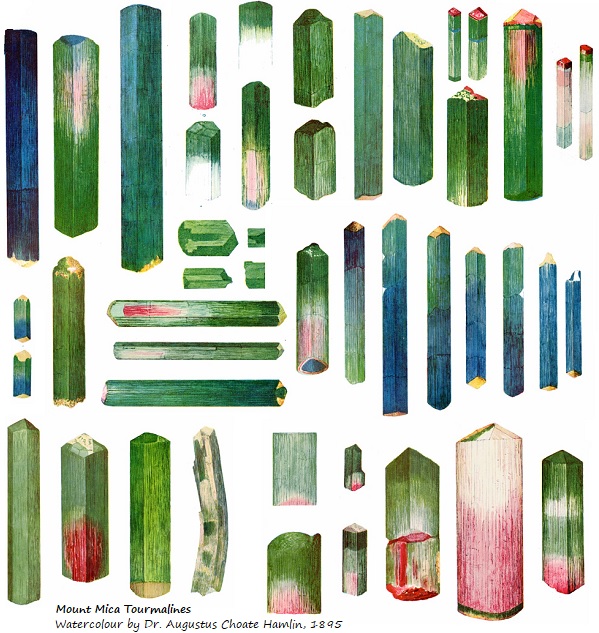
Beauty & Rarity, Mount Mica Peg
Mount Mica Quarry has been producing gemstones from the eighteen twenties to the present day -
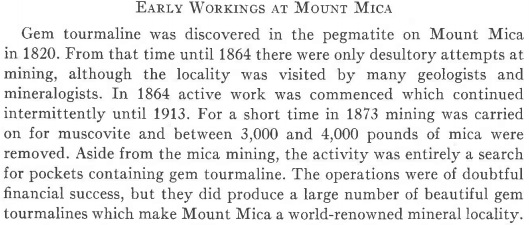

The superb tourmaline crystals at Mt. Mica are not the subject of this post however. Also found in the pegmatite were beryl crystals, and five (considerably more rare) beryllium minerals. This from Beryl at Mount Mica, Maine, Hurlbut & Wenden, 1951
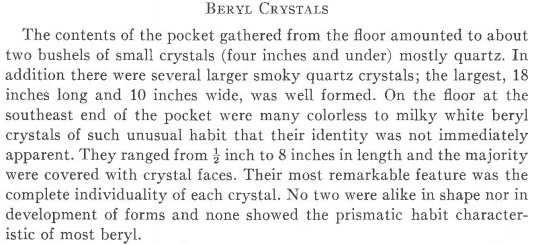

A more substantial occurrence of beryl was unearthed from the nearby Bumpus Quarry. These 18 feet beryl crystals were exposed in 1928 -

Although the Bumpus quarry wasn't around when the Andover meteorite fell, there's still a cosmic connection with these giant beryl crystals which vastly predates the formation of meteorites -
The Genesis of Beryllium
When you hold an beryl Be3Al2(SiO3)6 crystal, the atoms of beryllium in your hand were born in a completely different way to the silicon, aluminium and oxygen atoms. The elements beryllium, lithium and boron weren't forged by the big bang (like hydrogen & helium) or within the heart of exploding stars, like all the other elements.
The LiBeB Process
After hydrogen and helium, lithium, beryllium & boron are the lightest of the elements, but their relative abundance is poor -

This is because within the thermonuclear fusion furnace of a star, atoms of Li, Be & B are destroyed by proton capture as soon as they form.
All the beryllium in an emerald, phenakite or glucine has been produced by fission, rather than fusion. Interstellar atoms of carbon, nitrogen and oxygen, the debris of a supernova, are struck and torn apart by the most energetic particles known - cosmic rays. Beryllium atoms are what's left of heavier atoms after cosmic ray spallation.
As an aside within an aside, the dubious Norwegian mineral Hellandite-(Yb) contains all three elements produced by this interstellar cosmogenic nucleosynthesis -
(Ca,Y)4(Yb,Y)2(Al,Fe3+,Ti4+)[(Be,Li)2(O,F,OH)2|B4Si4O22]
As a side note within a double aside, to be absolutely accurate, only a significant fraction of the Universe's lithium is produced by cosmic ray spallation. Some is now known to be from big bang fusion and dying low mass stars.
Returning to the subject of beryl, I'd like to take a quick sidetrack, to a magnificent find of aquamarines in Madagascar. To maintain continuity with the title of this post, for reasons unknown even to myself, I'd like this find to have been illuminated by a bolide.
This is difficult. The Meteoritical Society has only one recorded fall (in the whole of Madagascar), that of the Maromandia meteorite of 2002. Unfortunately this 6 kg L5 chondrite's fireball was in the sky several hundred miles from the particular Madagascan Be deposit of interest.
Fortunately there's a report in the New York Times from 31st of July, 1977 of a fall which hasn't been verified, but would have been visible from the aquamarine bonanza (It'll do me, to keep some steam in this post) -
____________________
Madagascar Shaken As Meteorite Strikes
TANANARIVE [now Antananarivo], Madagascar, July 30 (Reuters)
A meteorite plunged earth in Madagascar today, causing a crater 240 yards across, Madagascar Radio reported. The impact was felt over a 250 mile radius of the capital.
The report said the meteorite split into two as it hit the atmosphere. Part fell to earth at Finanarantshoa [Fianarantsoa], 250 miles south of here, leaving the crater. The other crash point was not pinpointed but the radio said it fell in the Ankazobe region 62 miles west of here.
There were no reports of casualties but several windows were broken, according to the radio.
____________________
The "aquamarine" find, in its rose quartz matrix, at the Tsaramanga pegmatite -
Returning to Maine, where substantially smaller but also unusual aquamarine occurs, rather than the extraordinary Madagascan blue beryl. Henry Minot notes on his specimen of aquamarine from Mt. Mica, "Interestingly, it was a greenish-yellow color when it was mined, but then turned blue after less than an hour in the sunlight."
Mount Mica Beryllium Minerals
- Beryl varieties Goshenite, Morganite & Aquamarine Be3Al2(Si6O18)
- Bertrandite Be4(Si2O7)(OH)2
- Glucine CaBe4(PO4)2(OH)4 · 0.5H2O this calcium beryllium phosphate mineral is found only at Mt. Mica and its TL in the Urals.
- Greifensteinite Ca2Fe2+5Be4(PO4)6(OH)4 · 6H2O
- Mccrillisite (TL) NaCs(Be,Li)Zr2(PO4)4 · 1-2H2O the only known caesium phosphate mineral, with beryllium, lithium & zirconium thrown in for good measure.
- Moraesite Be2(PO4)(OH) · 4H2O
The type locality for glucine is Boevskoe in the Southern Urals. The Boevskoe Be deposit is within the Russian state Chelyabinsk Oblast, which is approximately the same size as Maine. Hosting 519 minerals, 45 of which are type localities, the state overshadows Maine's 357 with 10 (TL).
Before leaving the USA for Russia, here's a last look at some of Mt. Mica's non-beryllium minerals, of considerably more beauty than russian glucine -

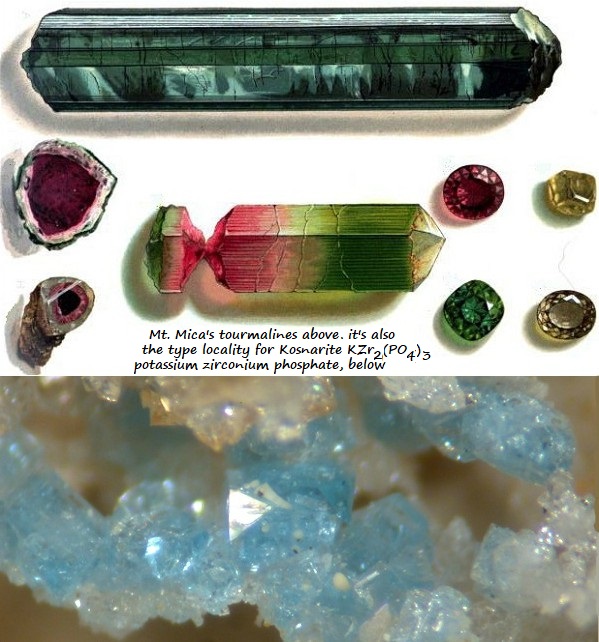
The Boevskoe Be deposit is the only other place worldwide that the rare (and disappointing to look at) mineral glucine is found. It's also the type locality for another very rare Be mineral, uralolite. Also a hydrated calcium beryllium phosphate Ca2Be4(PO4)3(OH)3 · 5H2O
 Left, Glucine. Right Uraloite. Both specimens from Boevskoe
Left, Glucine. Right Uraloite. Both specimens from Boevskoe
To make up for this deficiency of eye-candy, the Boevskoe Be deposit was illuminated from the south by an impressive superbolide on the 15th Feb. 2013 -
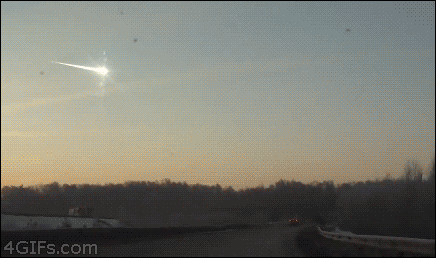

The Chelyabinsk meteor was a lump of rock substantially larger than Maine's Andover Aerolite of 1898. It fortunately had a shallow angle of atmospheric entry, the kinetic energy of this 20 meter chondrite traveling at 40,000 mph+ was expended in the atmosphere. From Wikipedia -
"The light from the meteor was brighter than the Sun, visible up to 100 km (62 mi) away. It was observed over a wide area of the region and in neighboring republics. Some eyewitnesses also felt intense heat from the fireball..... The bulk of the object's energy was absorbed by the atmosphere, with a total kinetic energy before atmospheric impact estimated from infrasound and seismic measurements to be equivalent to the blast yield of 400–500 kilotons of TNT (about 1.4–1.8 PJ) range – 26 to 33 times as much energy as that released from the atomic bomb detonated at Hiroshima."

The photo above had me thinking for some time after it was published in 2013. The double vortex smoke trail from the bolide was unexpected and perplexing to me. However, if you consider those moments when the meteor was at its brightest, the power output along its path can be likened to a continuous atomic explosion. The initial fireball of a nuclear weapon quickly becomes a rapidly ascending hot vortex ring - a mushroom cloud. The Chelyabinsk meteor trail is a linear mushroom cloud.
After the airburst, a large quantity of small meteorites were recovered by locals. The location of falls were apparent from the holes in snow, recovery by feeling for the melted snow, refrozen onto the cooled LL chondrite fragments -
The impact of a large fragment through the ice of Chebarkul lake was captured on a security camera. I've made a gif from the video, which shows the ice and snow plume drifting west from the impact point -


OK, it's a rather underwhelming video clip, but it's the only photographic record of an actual impact of any aerolite! Here's the video of the recovery of the 1,442 lb meteorite from the bed of lake Chebarkul -
The Beryllium & Meteorite Connection
So.... what's the deal with beryllium minerals and meteorites? It's a tenuous link I'm afraid! That said, interesting......
Beryllium, as has been mentioned, was originally created by the cosmic ray spallation of heavier atoms such as oxygen in high cosmic ray flux and nova debris volumes of interstellar space. This is also happening right now on Earth. Every second, 1.5×1017 (that's 150,000 trillion) atoms of Be-10 are produced by cosmic rays hitting the Earth's atmosphere. Beryllium-10 (10Be) is a radioactive isotope of beryllium. It is formed in the Earth's atmosphere mainly by cosmic ray spallation of nitrogen and oxygen. Beryllium-10 has a half-life of 1.39 × 106 years, and decays by beta decay to stable boron-10.

By measuring the beta decay of Be-10 in (and on) meteorites, together with data from other cosmogenic radionuclides, the terrestrial age of meteorites can be determined. For those with an interest in dating, see the first four links below -
References -
Beryllium-10 in Iron Meteorites, Their Cosmic-Ray Exposure and Terrestrial Ages. Chang & Wänke, 1969
Surface exposure dating, Wikipedia
Terrestrial Ages of Meteorites. A. J. Timothy Jull
Modelling the stratospheric budget of beryllium isotopes. Gilles Delaygue et al, 2015
Description of Four Meteorites, Henry A. Ward, 1902
The History of Mount Mica & its Wonderful Deposits of Matchless Tourmalines. Augustus Choate Hamlin, 1895
New Tourmaline Production: From Mount Mica, Maine America's First Gem Pegmatite. Simmons et al, 2005
Beryl at Mount Mica, Maine, Hurlbut & Wenden, 1951
And Now For Something Completely Different